Fantasy Books
Snake Eyes by Mark Henwick
Urban Fantasy
This is book 8 in the Amber Farrell / Bite Back series. To start at the beginning read the novella Raw Deal or Book 1, Sleight of Hand.

The first four of five books in the series were very much about discovery. Amber Farrell who is vampire, werewolf and witch was learning who she was. All the while battling the bad guys and each supernatural community where she was considered an abomination.
The more recent books have been about joining her separate parts, I guess “becoming” is a good word. And the last couple of books, Queen of Diamonds and Snake Eyes (essentially one book broken into two parts) seem to me to be her arriving at who she is.
This series is honestly one of the best. If you look at the books I read, you’ll notice 90% plus are written by women. Mark Henwick is one of a handful of male authors I read and reread. I’ve probably read most of the books in this series a dozen times. So if you love Urban Fantasy, do yourself a favour. Read Amber Farrell.
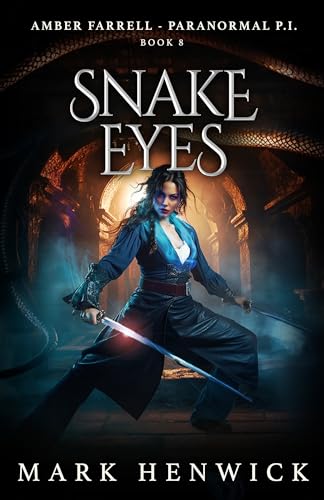
Audiobook Review: Tartufo by Kira Jane Buxton
I received a review copy from the publisher. This does not affect the contents of my review and all opinions are my own.
Mogsy’s Rating (Overall): 3.5 of 5 stars
Genre: Contemporary, Humor
Series: Stand Alone
Publisher: Hachette Audio (January 28, 2025)
Length: 11 hrs and 31 mins
AuthorInformation: Website | Twitter
Narrator: Caroline Hewitt
After thoroughly enjoying Kira Jane Buxton’s Hollow Kingdom series, I was looking forward to checking out Tartufo even though her newest novel falls outside my usual genres. I was mainly curious to see how her quirky sense of humor would transfer to a different kind of story, and while Tartufo does indeed take a more grounded approach, it still carries the author’s signature charm. Still, despite its playfulness and whimsy, the novel didn’t quite capture me in the same way as her previous work.
Set in the small, fictional Italian village of Lazzarini Boscarino, Tartufo tells the tale of a group of residents who will do anything to keep their dying town on the map. With most of the younger generation having departed for greener pastures in the big cities, the remaining aging population is left to hold what’s left of their beloved home together. But the crisis deepens as it is revealed that the previous mayor had died without leaving any available funds for rebuilding and revitalizing. Now his daughter Delizia returns home to handle his affairs only to find herself elected as the new mayor—after nearly losing the race to a donkey—with the unenviable task of turning things around, all the while struggling with her own personal ambitions and disappointments.
Then one day, a local truffle hunter named Giovanni heads out into the forest with his dogs, doing what he loves most, when he suddenly stumbles upon an enormous truffle—quite possibly the largest specimen the world has ever seen. Realizing its potential, Giovanni brings it to the rest of the village, hoping it’s exactly what they need to bring attention back to Lazzarini Boscarino. However, what begins as a stroke of extraordinary luck soon spirals out of control as the attention the town receives also includes that of the negative variety, motivated by enmity and greed. Instead of bringing the community together, the discovery of the truffle threatens do the exactly opposite, forcing everyone to question what future they want for their town.
If you’re looking for some casual reading or a book to sit back and relax with, Tartufo is the perfect choice—relatively low stakes, brimming with charm and wit. For me, it felt a lot like watching a lighthearted musical. The human characters are oddballs, with some portrayals leaning into satire and caricature, filling the cast with over-the-top personalities that wouldn’t feel too out of place in a stage comedy. The novel is also a treat for the senses. Descriptive writing is dialed up to the max, painting a gorgeously evocative picture of the setting. The Italian countryside is described so vividly you can practically smell the delicious scent of food and wine in the restaurants and feel the warmth under the Mediterranean sun. The village of Lazzarini Boscarino is itself as much a character as its eccentric inhabitants, written with the same amount of care and detail.
Buxton has also chosen to tell this story in an omniscient point of view, a brilliant decision which allowed her to do something that has become part of her signature style—writing from the perspective of animals. Inserted between character POVs are scenes told through the eyes of creatures like Giovanni’s truffle-hunting dog, a cat named Al Pacino (despite it being female), and even a passing honeybee. Not only is it reminiscent of the Hollow Kingdom series, which was told through the eyes of a very clever crow, it’s a quirk of the writing which adds an unexpected layer of depth to the story.
Despite the whimsical nature of Tartufo, there’s a distinct lack of supernatural elements, though that alone didn’t take away from my enjoyment. More challenging was the way the narrative juggles so many different POVs, leaving some important characters underdeveloped. It’s also a little too silly in places, making it harder for me to fully immerse myself in the conflict, and there were moments where I wished for more emotional depth.
Nevertheless, Tartufo remains a delightful read, showcasing Kira Jane Buxton’s storytelling abilities. While the playful tone occasionally goes overboard with it and becomes tiresome, on the whole the book is entertaining and endearing. At its heart, it’s a story about togetherness and the dreams of a community, and though I didn’t connect with it as deeply as the author’s Hollow Kingdom, I still had a good time with its humor and themes.
![]()
![]()
The Fiction of Edgar Rice Burroughs, Part II: Tarzan and The Land That Time Forgot
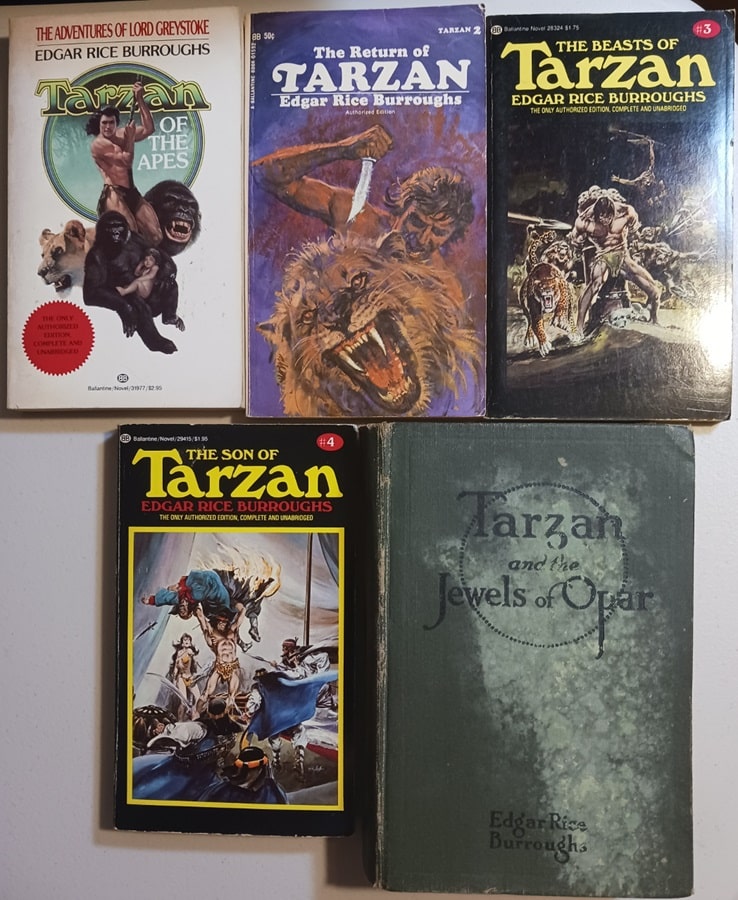 Tarzan novels #1 – #5 : Tarzan of the Apes, The Return of Tarzan, The Beasts of Tarzan, and The Son of Tarzan (Ballantine Books, December 1983, April 1969, April 1975, April 1975), and Tarzan and the Jewels of Opar (A.L. Burt, 1919). Covers by Charles Ren, Bob Abbett, Neal Adams, and Neal Adams.
Tarzan novels #1 – #5 : Tarzan of the Apes, The Return of Tarzan, The Beasts of Tarzan, and The Son of Tarzan (Ballantine Books, December 1983, April 1969, April 1975, April 1975), and Tarzan and the Jewels of Opar (A.L. Burt, 1919). Covers by Charles Ren, Bob Abbett, Neal Adams, and Neal Adams.
Any discussion of Sword & Planet fiction needs to start with Edgar Rice Burroughs and his book A Princess of Mars. I discussed that series extensively — and also his other S&P series, the Carson of Venus books, and his Moon Maid trilogy, which is partially S&P — in Part I of this series.
But, of course, ERB wrote many other books that have no connection to S&P fiction. They are still very good stories, though, entertaining and worth discussing. I thought I’d cover some in my next series of posts.
Most readers I know discovered ERB through the character of Tarzan. The first ERB I read was A Princess of Mars, but the second one was Tarzan Lord of the Jungle. The book was an old hardback, with no dust cover. The cover was generally brown with the title embossed on it. I found it among my sister’s books. She was the only other big reader in my family. I don’t know how she came upon it. I still remember some fifty+ years later the opening scene, with Tarzan dozing on the back of Tantor the elephant. And before long Tarzan finds a lost civilization of crusaders in deepest Africa. And there was swashbuckling.
[Click the images for Tarzan-sized versions.]
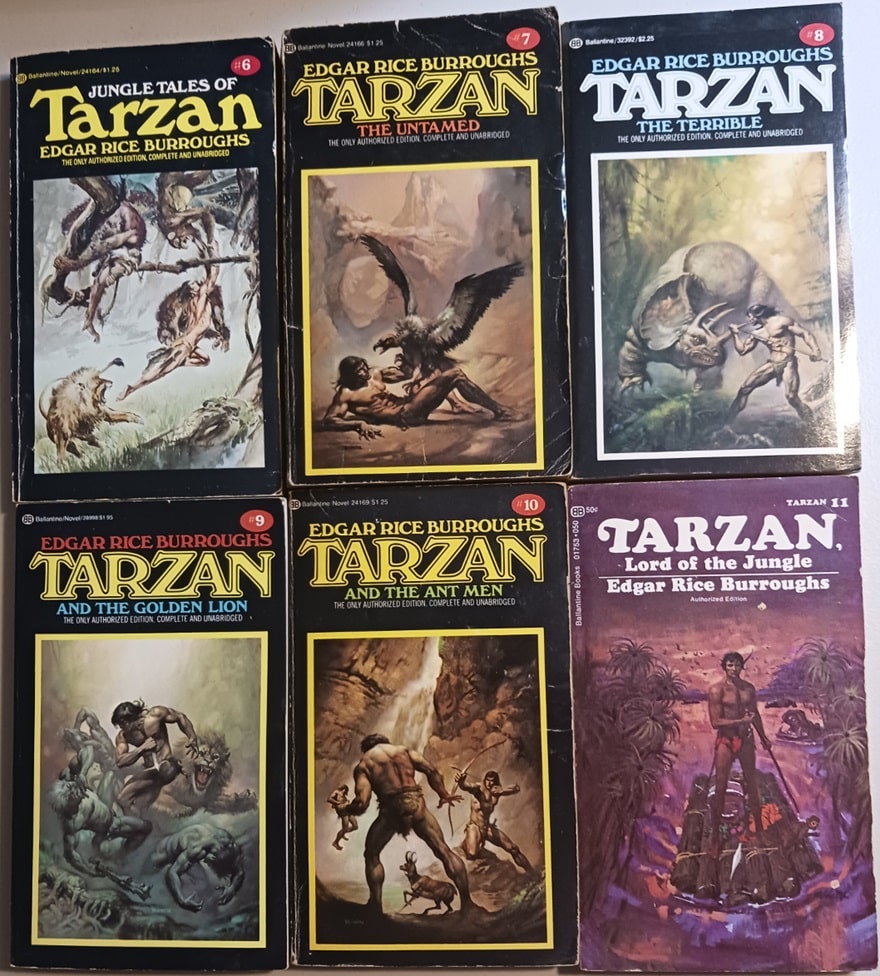 Tarzan #6 – #11: Jungle Tales of Tarzan, Tarzan the Untamed, Tarzan the Terrible, Tarzan and the Golden Lion, Tarzan and the Ant Men, and Tarzan, Lord of the Jungle (Ballantine Books, 1975-1976, and 1969). Covers by Neal Adams, Boris Vallejo, and Bob Abbett.
Tarzan #6 – #11: Jungle Tales of Tarzan, Tarzan the Untamed, Tarzan the Terrible, Tarzan and the Golden Lion, Tarzan and the Ant Men, and Tarzan, Lord of the Jungle (Ballantine Books, 1975-1976, and 1969). Covers by Neal Adams, Boris Vallejo, and Bob Abbett.
I’ve always liked best the Tarzan tales where he discovers a lost race. There were a lot of them in Africa, apparently. That copy of the book fell apart and I eventually replaced it with a paperback. When I started buying the Tarzan books I couldn’t afford to get them all at once, and I also picked up ones here and there from used bookstores or book sales. Most of the ones I found were from the Ballantine editions, many with great Boris Vallejo covers, which became my “mind’s eye” image of Tarzan.
Above I show the first 11 books in my collection. All but Jewels of Opar are from Ballantine, published between 1963 and 1973 it looks like. Covers are varied.
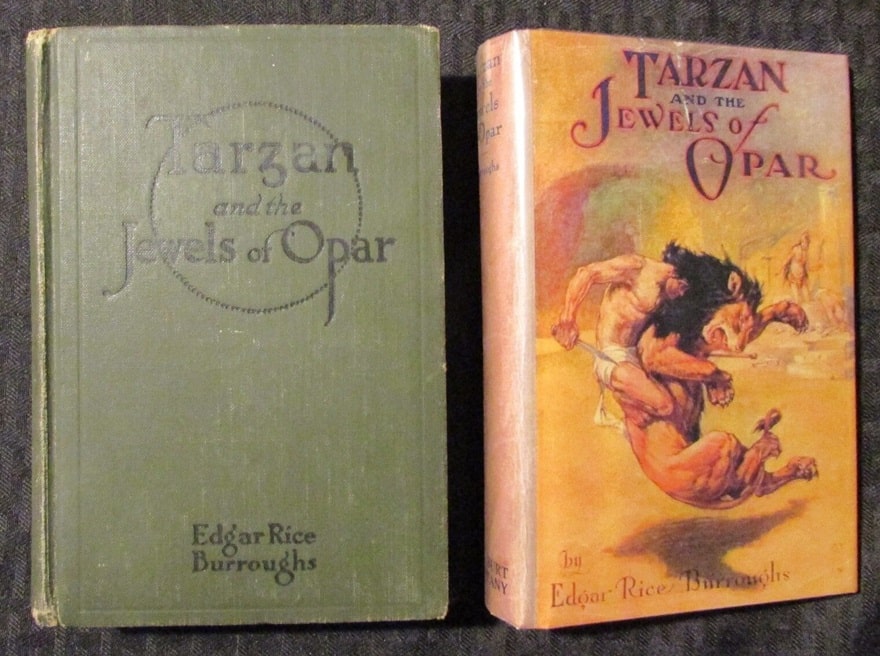 Tarzan and the Jewels of Opar (A.L. Burt Company, 1919). Cover by J. Allen St. John
Tarzan and the Jewels of Opar (A.L. Burt Company, 1919). Cover by J. Allen St. John
Here’s the list of cover artists.
Tarzan of the Apes; Charles Ren
The Return of Tarzan; Robert Abbett
Beasts of, Son of, Jungle Tales of; Neal Adams
Untamed, Terrible, Golden Lion, Ant Men; Boris Vallejo
Lord of the Jungle; Robert Abbett
My copy of Tarzan and the Jewels of Opar was published in 1919 by A. L. Burt Company. It lacks a dust cover, but above is a picture I took off the internet of what it apparently looked like. The beautiful cover is by J. Allen St. John (1872 – 1957), who was an incredible artist.
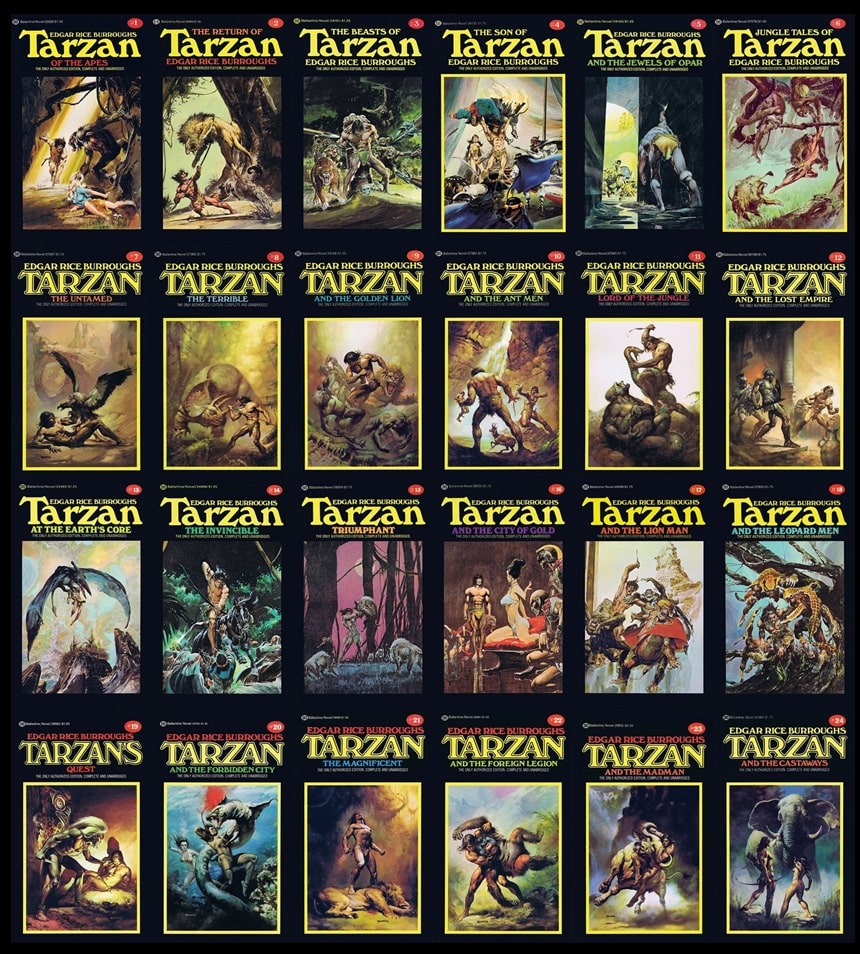 The 24 Tarzan novels and collections published in sequence in paperback by Ballantine Books, 1975 – 1977. Covers by Neal Adams and Boris Vallejo
The 24 Tarzan novels and collections published in sequence in paperback by Ballantine Books, 1975 – 1977. Covers by Neal Adams and Boris Vallejo
Burroughs wrote 26 books about Tarzan, but typically only 24 are counted as part of the main sequence. The two odd numbers out are The Tarzan Twins, which I have, and Tarzan and the Tarzan Twins with Jad-Bal-Ja The Golden Lion, which I’ve never seen. These are novellas written for young readers. They were published separately but were collected together at one point, although I can’t find a copy of that publication.
The copy of The Tarzan Twins that I have is from Wildside Press with a cover by Douglas Grant. It’s the only ERB book I don’t like and doesn’t even seem like ERB to me. ERB’s work was already accessible to young readers. Most people I know read them pretty young, so for him to “try” to write down to kids just didn’t work — at least to me.
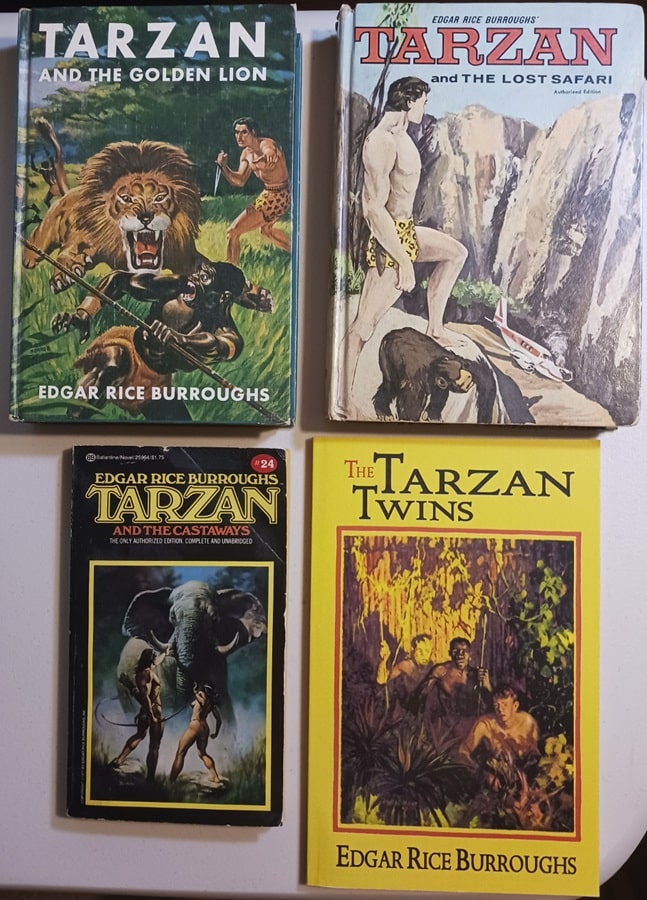 Tarzan and the Golden Lion (Grosset & Dunlap, 1949), Tarzan and the Lost Safari (Whitman Publishing, January 1, 1966, author unknown), Tarzan and the Castaways (Ballantine, September 1977), and The Tarzan Twins (Wildside Press, September 14, 2005). Covers by C. Edmund Monroe, Jr., Tony Sgroi, Boris Vallejo, and Douglas Grant.
Tarzan and the Golden Lion (Grosset & Dunlap, 1949), Tarzan and the Lost Safari (Whitman Publishing, January 1, 1966, author unknown), Tarzan and the Castaways (Ballantine, September 1977), and The Tarzan Twins (Wildside Press, September 14, 2005). Covers by C. Edmund Monroe, Jr., Tony Sgroi, Boris Vallejo, and Douglas Grant.
Overall, the Tarzan series is certainly not my favorite among ERB’s work anyway. They’re actually fairly low on my list of ERB favorites, although — don’t get me wrong — still very good. A ranking of my favorite series would be John Carter, Moon Maid, Carson of Venus, Land that Time Forgot, and Pellucidar, with Tarzan coming after that. Some of my favorite standalones would be The Outlaw of Torn, The Mad King, and I Am A Barbarian.
The Tarzan tales were almost certainly influenced by Rudyard Kipling’s jungle book tales of Mowgli, the wild boy of the forest — which in turn was influenced by some true reports from the mid-1800s of children in India being raised by wolves. ERB may have been directly aware of those same tales as well, and likely knew of the “Wild Boy of Aveyron,” who, around 1800, was found living in the wilds in France. The French feral child was named Victor by one of his “rescuers.” Unlike Tarzan, he never really learned to speak, although he apparently understood some language.
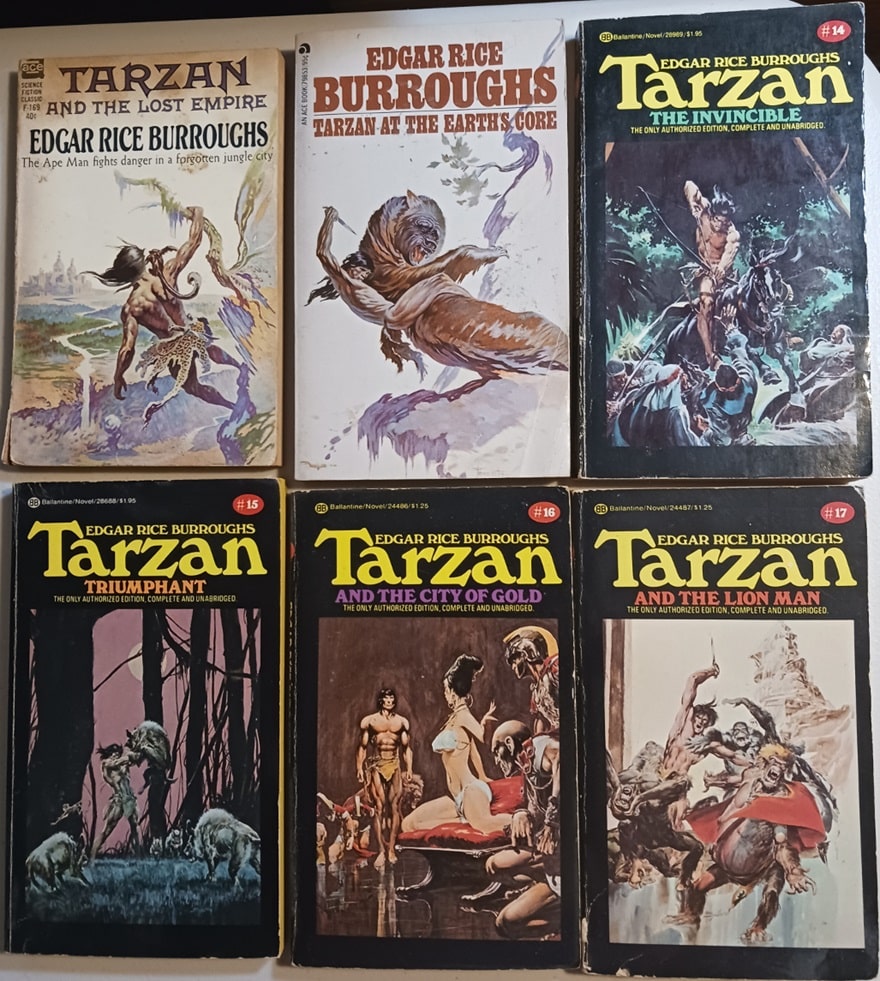 Tarzan #12 – #17: Tarzan and the Lost Empire and Tarzan at the Earth’s Core (Ace Books, November 1962 and March 1963), and Tarzan the Invincible, Tarzan Triumphant, Tarzan and the City of Gold, and Tarzan and the Lion Man (Ballantine Books, November 1975). Covers by Frank Frazetta and Neal Adams.
Tarzan #12 – #17: Tarzan and the Lost Empire and Tarzan at the Earth’s Core (Ace Books, November 1962 and March 1963), and Tarzan the Invincible, Tarzan Triumphant, Tarzan and the City of Gold, and Tarzan and the Lion Man (Ballantine Books, November 1975). Covers by Frank Frazetta and Neal Adams.
Above and below are the remaining Tarzan book pictures from my collection. The Ace copy of Lost Empire with the Frazetta cover that looks like it was inspired by Roy Krenkel Jr’s work is a real prize. I also have an Ace copy of Tarzan at the Earth’s Core, which also ties into ERB’s Pellucidar series, with a wonderful Frazetta cover.
The rest of my regular series are all Ballantine, with the following cover artists.
Invincible, Triumphant, City of Gold, Lion Man, Leopard Men; Neal Adams
Quest, Forbidden City, Magnificent, Foreign Legion, Madman, Castaways; Boris Vallejo
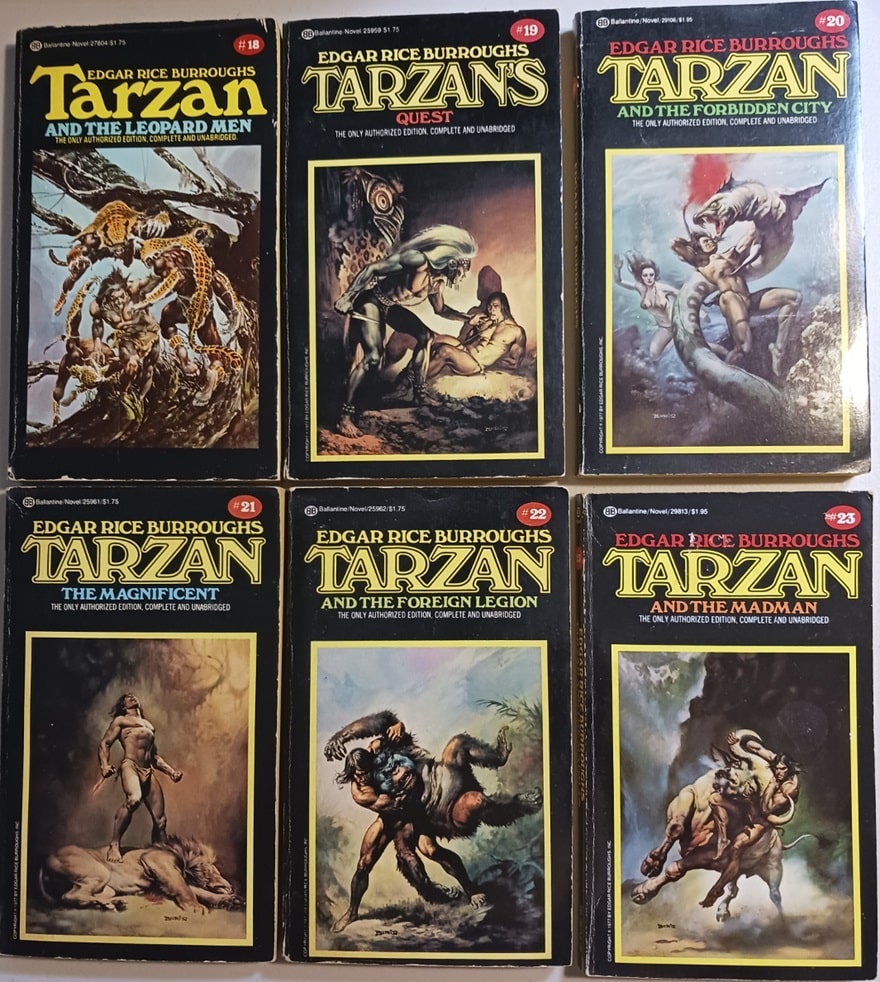 Tarzan #18 – #23: Tarzan and the Leopard Men ((Ballantine Books, November 1975, cover by Neal Adams), and Tarzan’s Quest, Tarzan and the Forbidden City, Tarzan the Magnificent, Tarzan and the Foreign Legion, and Tarzan and the Madman (Ballantine Books, September 1977, covers by Boris Vallejo).
Tarzan #18 – #23: Tarzan and the Leopard Men ((Ballantine Books, November 1975, cover by Neal Adams), and Tarzan’s Quest, Tarzan and the Forbidden City, Tarzan the Magnificent, Tarzan and the Foreign Legion, and Tarzan and the Madman (Ballantine Books, September 1977, covers by Boris Vallejo).
My second copy of Tarzan and the Golden Lion is from Grosset & Dunlap and clearly looks targeted toward younger readers with that cover (see above) — which is pretty cringeworthy for moderns. Not sure when it was published or who the cover artist might be.
Tarzan and the Lost Safari is adapted from the Tarzan movie of that same name. It was published by Whitman and doesn’t list an author, although I’ve seen Frank Castle’s name attached to it. I’ve seen this book for sale as by “Edgar Rice Burroughs.” It’s not. It’s closer to the movie Tarzan than to ERB’s creation. I didn’t find it very entertaining.
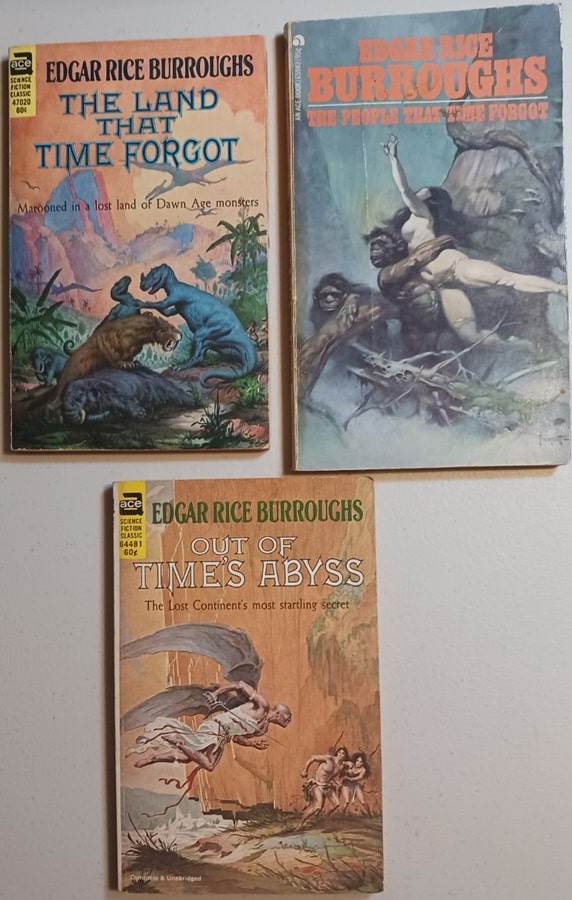 Three novels of The Lost Continent by Edgar Rice Burroughs: The Land That Time Forgot, The People That Time Forgot, and Out of Time’s Abyss (Ace Books, 1963, January 1973, and October 1963). Covers by Roy Krenkel, Jr, Frank Frazetta, and Roy Krenkel, Jr.
Three novels of The Lost Continent by Edgar Rice Burroughs: The Land That Time Forgot, The People That Time Forgot, and Out of Time’s Abyss (Ace Books, 1963, January 1973, and October 1963). Covers by Roy Krenkel, Jr, Frank Frazetta, and Roy Krenkel, Jr.
I personally don’t believe that ERB has been well served by the film and TV industries. I may be in the minority here but I find the early Tarzan movies to be virtually unwatchable. They seem to have very little to do with ERB’s characterization of Tarzan. The first Tarzan movie I actually liked was Greystoke: The Legend of Tarzan, starring Christopher Lambert. It still wasn’t the Tarzan I knew from the books but they made an effort to capture some of the character’s origins. I also liked most of the 2016 Legend of Tarzan, with Alexander Skarsgard, who I believe captured the essence of the character better than any previous Tarzan.
I generally liked the John Carter of Mars film, although they made changes that weren’t needed, but my favorite ERB adaptations are definitely a couple of B-movies starring Doug McClure. I’m talking about The People that Time Forgot, and The Land that Time Forgot. I’ve given these — especially the first one — frequent rewatches. Although the special effects are pretty awful by modern standards, the spirit of ERB’s stories shine through, the mystery and the exotic.
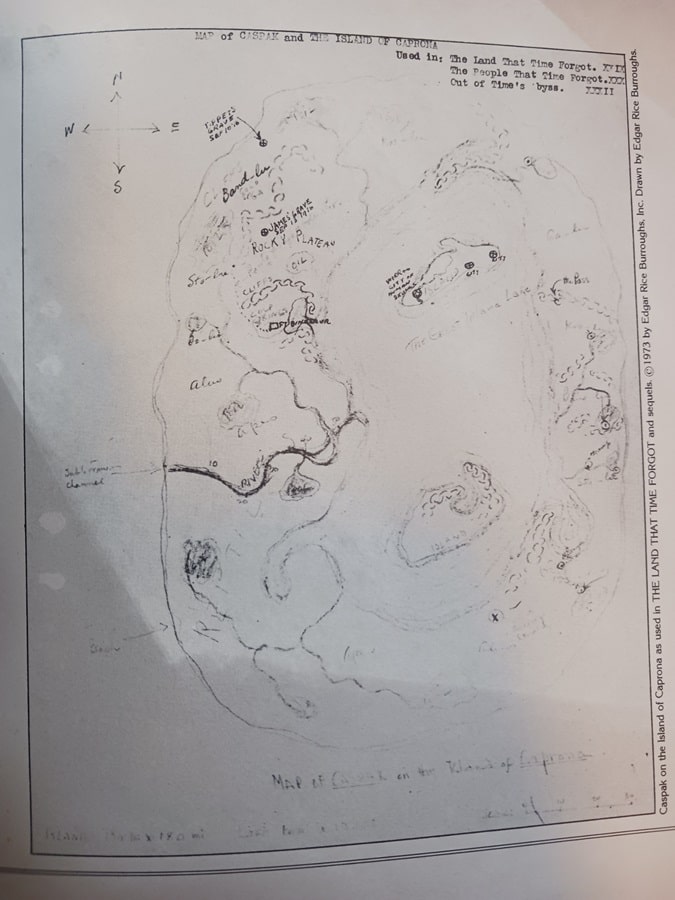 A map of Caprona, the Land that Time Forgot, from An Atlas of Fantasy by J. B. Post (Ballantine Books, 1979)
A map of Caprona, the Land that Time Forgot, from An Atlas of Fantasy by J. B. Post (Ballantine Books, 1979)
Of course, I loved the trilogy that spawned these movies — The Land that Time Forgot, The People that Time Forgot, and Out of Time’s Abyss. I thought Doug McClure did a good job with the character of Bowen Tyler, who becomes the first American to set foot on Caprona, a lost world near Antarctica where time seems to have stopped and dinosaurs still survive. There’s also a deep mystery about how things “evolve” on Caprona, though I won’t give it away.
Above are the three copies I have, all from Ace. Frazetta did the cover for The People while the other two are by Roy Krenkel, Jr. I’m also including a map of Caprona featured in An Atlas of Fantasy.
More on Burroughs next time.
Charles Gramlich administers The Swords & Planet League group on Facebook, where this post first appeared. His last article for Black Gate was The Fiction of Edgar Rice Burroughs, Part I: Sword and Planet.
The Intersection of Hobbies: Dungeons & Dragons, John Eric Holmes, and Tarzan
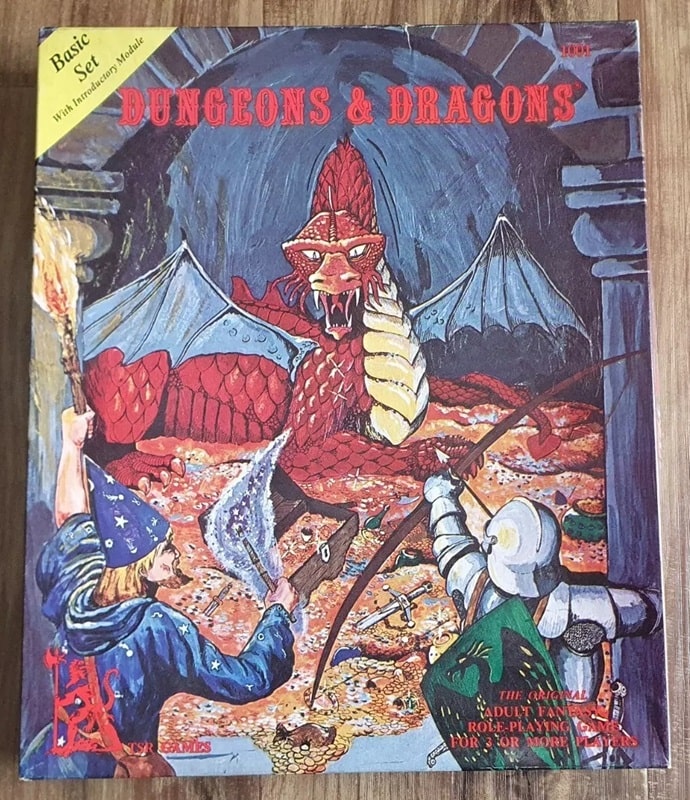 Dungeons & Dragons Basic Set by John Eric Holmes, based on Dungeons & Dragons by Gary Gygax and Dave Arneson (TSR Games, 1977). Cover by David Sutherland
Dungeons & Dragons Basic Set by John Eric Holmes, based on Dungeons & Dragons by Gary Gygax and Dave Arneson (TSR Games, 1977). Cover by David Sutherland
There are many intersections between my favorite hobby (which is also my line of work) and my favorite fiction. One of these intersections is represented by Dr. John Eric Holmes and the fiction of Edgar Rice Burroughs.
When I was a youth, the first Dungeons & Dragons set that I owned was edited by Dr. Holmes. That “basic” set served as the foundation to my understanding of all things D&D. Now, this was in 1981, when I was in the fifth grade. This was also the year in which I was devouring Tarzan novels, written by Edgar Rice Burroughs. My keen interest in Tarzan was fueled by the CBS Saturday morning cartoon, Tarzan, Lord of the Jungle.
[Click the images for Tarzan-sized versions.]
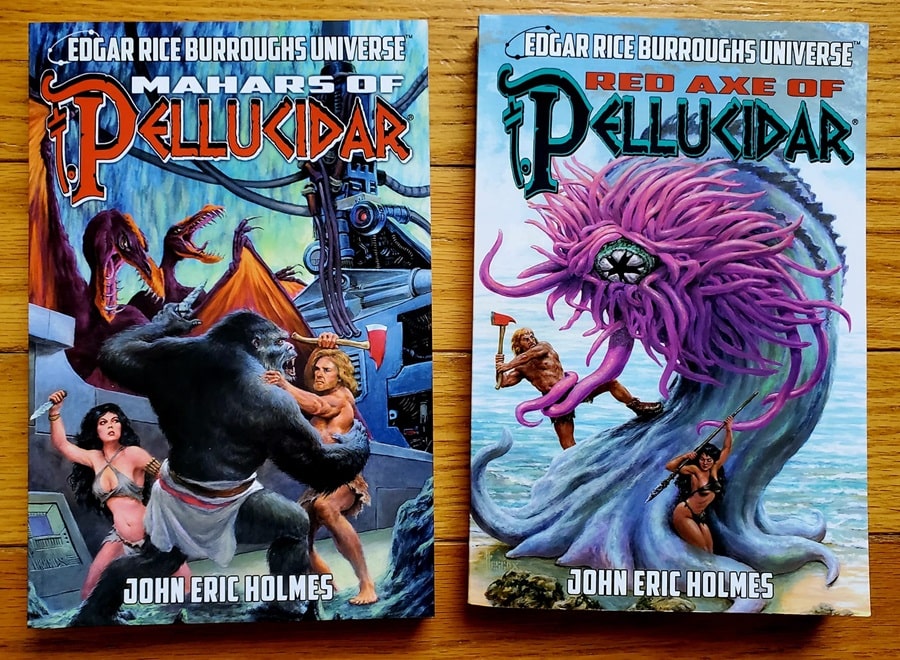 Pellucidar novels by John Eric Holmes: Mahars of Pellucidar and Red Axe of Pellucidar (Edgar Rice Burroughs, Inc., September 6, 2022). Covers by Richard Hescox
Pellucidar novels by John Eric Holmes: Mahars of Pellucidar and Red Axe of Pellucidar (Edgar Rice Burroughs, Inc., September 6, 2022). Covers by Richard Hescox
As I got older, I delved into other works by Burroughs, such as the Barsoom, Amtor, and Pellucidar stories. It wasn’t until recent years that I learned that Dr. Holmes had written two Pellucidar novels himself, the first of which was published in his lifetime, the other which was not: Mahars of Pellucidar and Red Axe of Pellucidar.
I am looking forward to reading these two books soon, probably spaced between my Zelazny readings. It’s nice to see that each of these books includes a foreword by Chris Holmes, one of Dr. Holmes’ children, whom I have had the pleasure to speak with several times at North Texas RPG Con.
 The complete Tarzan novels and collections by Edgar Rice Burroughs, published in paperback by Ballantine Books, 1975 – 1977. Covers by Neal Adams and Boris Vallejo
The complete Tarzan novels and collections by Edgar Rice Burroughs, published in paperback by Ballantine Books, 1975 – 1977. Covers by Neal Adams and Boris Vallejo
When I was young, my first exposure to Tarzan, created by Edgar Rice Burroughs, was the 1966 Tarzan TV series, starring Ron Ely. This was followed by the 1976–1980 animated series, Tarzan, Lord of the Jungle, which really captured my imagination.
I can still hear my brother Bob doing his “Bolmangani” voice from that cartoon. (The Bolmangani were evil gorilla-men that Tarzan often faced.) The show was excellent, and I particularly enjoyed the opening narration:
The jungle: Here I was born; and here my parents died when I was but an infant. I would have soon perished, too, had I not been found by a kindly she-ape named Kala, who adopted me as her own and taught me the ways of the wild. I learned quickly, and grew stronger each day, and now I share the friendship and trust of all jungle animals. The jungle is filled with beauty, and danger; and lost cities filled with good, and evil. This is my domain, and I protect those who come here; for I am Tarzan, Lord of the Jungle!
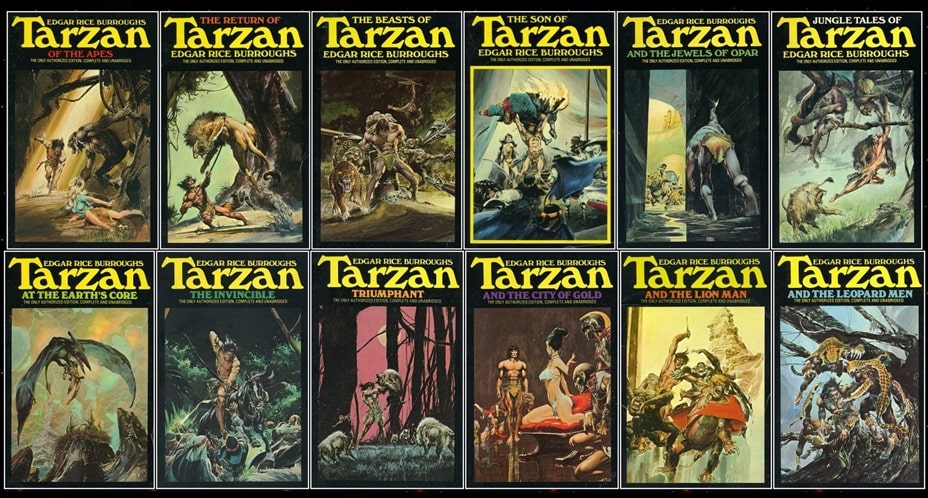 The twelve Neal Adams covers for the Ballantine Tarzan.
The twelve Neal Adams covers for the Ballantine Tarzan.
It was some time around 1981 that I began reading the actual ERB Tarzan books. I was completely enthralled within a few pages. The writing style of ERB was something like I’d never encountered before.
Pictured below is the cover art for the first Tarzan novel that I read, Tarzan of the Apes, published in 1977 by Ballantine Books. It was painted by Neal Adams, whose art was superb. In fact, I am of the opinion that Neal did the finest rendition of Batman to this day.
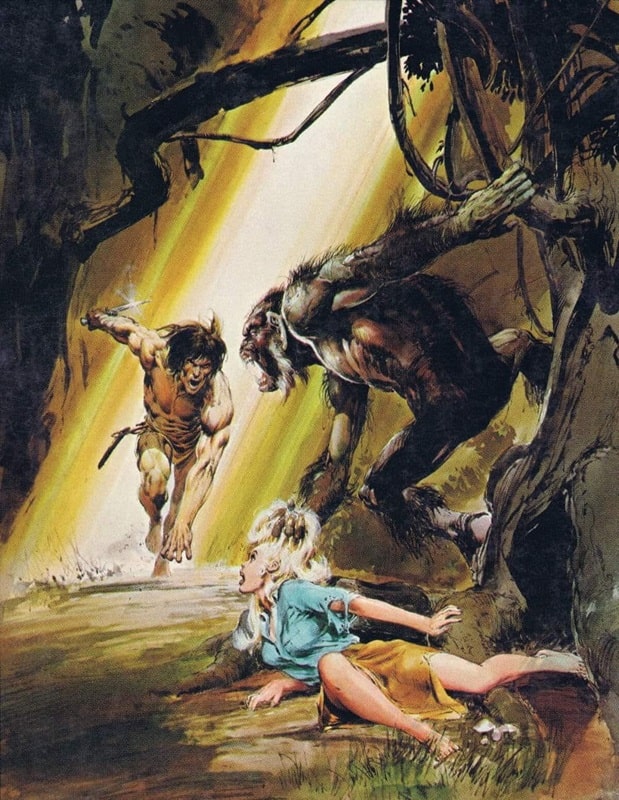 Cover art for Tarzan of the Apes by Neal Adams
Cover art for Tarzan of the Apes by Neal Adams
Anyway, the Neal Adams art is what drew me to purchase the first Tarzan book at my local Walden Books. It led me to a lifelong fascination with the incredibly imaginative works of Edgar Rice Burroughs.
In fact, I can open any ERB book to any random page, start reading, and find myself sucked into a world of wonder.
Jeffrey P. Talanian’s last article for Black Gate was Savage Sword of Conan is Back. He is the creator and publisher of the Hyperborea sword-and-sorcery and weird science-fantasy RPG from North Wind Adventures. He was the co-author, with E. Gary Gygax, of the Castle Zagyg releases, including several Yggsburgh city supplements, Castle Zagyg: The East Mark Gazetteer, and Castle Zagyg: The Upper Works. Read Gabe Gybing’s interview with Jeffrey here, and follow his latest projects on Facebook and at www.hyperborea.tv.
Is Sophie’s Choice a True Story? – Revisiting “Sophie’s Choice”
Is Sophie's Choice a true story? Styron based his novel on his memory of a real-life woman named Sophie, a survivor of Auschwitz he met in Brooklyn.
The post Is Sophie’s Choice a True Story? – Revisiting “Sophie’s Choice” appeared first on LitStack.
The Antidote
Fans of Barbara Kingsolver’s Demon Copperhead will want to grab this gorgeous magical-realist novel set on the Nebraska prairie during the height of the Dust Bowl climate disaster. Russell, a MacArthur grant winner, is best known for her collections of short stories, and this is only her second novel after the 2012 Pulitzer finalist Swamplandia! It is well worth the wait, offering a ferociously moving meditation on America’s refusal to come to terms with the violence and injustice of its own past. The story begins on “Black Sunday,” April 14, 1935, when tornadic dust storms destroyed farmland throughout the Great Plains, and a variety of point-of-view characters lead the reader to an intimate understanding of the Great Midwestern Drought that decimated the farmlands of the American prairie and worsened the Great Depression.
The premise sounds grim, but Russell draws on some of our most enchanting national myths to bring these characters to life. The alert reader will quickly realize that yes, this novel is set in the fictional town of Uz, Nebraska, in the depths of the Dust Bowl Depression, and yes, the inhabitants are menaced by dust tornados, and yes, the main characters are a scrappy orphan girl, a mysterious scarecrow, a stiff midwestern bachelor searching for love, and an exhausted prairie witch whose task it is to collect the toxic memories of her neighbors and store them away inside herself. But Russell’s evocations of L. Frank Baum’s American fairytale are subtle and never distract from the gritty, tender, fierce realism of this expansive story. The supernatural elements of the novel are infused with such a deep, compassionate humanity that the reader never has the sense that this is anything but a completely true story. Russell has created a masterpiece that will probably be on many 2025 award lists.
The post The Antidote appeared first on Historical Novel Society.
The Ballad of Mary Kearney
Ireland, 1765. When young Mary Kearney is sent to work at Goward Hall, she joins her brother and sister in service and lightens the load of her impoverished father, who has too many mouths to feed. She begins to wait on the very married Lady Mitchelstown, who is involved in a scandalous romance with Lord and Lady Goward’s son James. James eventually arranges for Mary to learn to read and write, and as they become much closer, the outrage of both the upper and lower classes descends upon them. They enter into a secret marriage, but in the eyes of the world, Mary is a mistress, and only a few at the time know that she is James’ wife. And nearby, an evil man waits, determined to ruin Mary for good.
Late 18th to early 19th-century Ireland comes alive in this book, as the characters speak to us from the past in dialect true to the time. There is a great deal of epistolary work, and it is woven in beautifully. Letters, articles, documents, and diary entries highlight the many voices, bringing each character to life with great effect. The novel begins with the dictated words of Mary’s father, who cannot read or write. The letters contain everything from love to gossip to threats, depending upon the writer. The class differences of the time are highlighted well, and the Catholic versus Protestant conflict is explored. The attempted uprising by the United Irishmen is well researched, and its consequences spill across the page. The captivating love story of James and Mary endures many hardships, including plotting and scheming from wicked people. Honest and intriguing, this gripping saga will transport and inspire you, and it just might break your heart. Highly recommended.
The post The Ballad of Mary Kearney appeared first on Historical Novel Society.
GRAVE EMPIRE by Richard Swan
Spies, Cowboys, Anarchists, O My: Polostan by Neal Stephenson
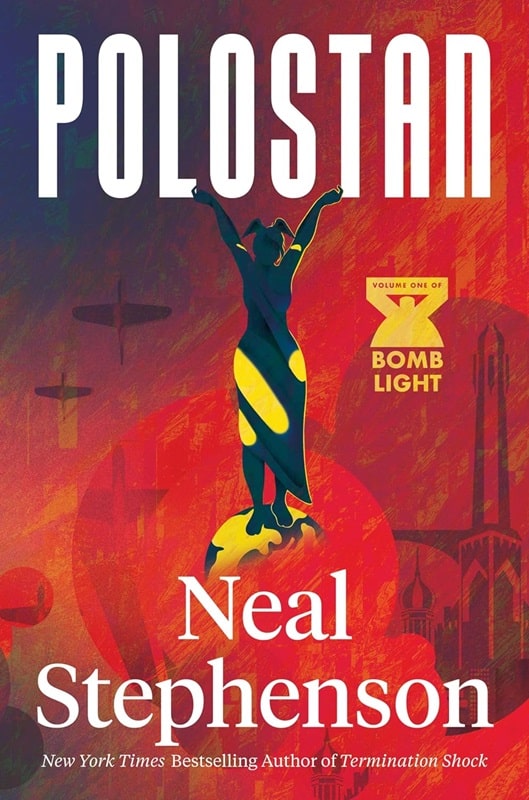
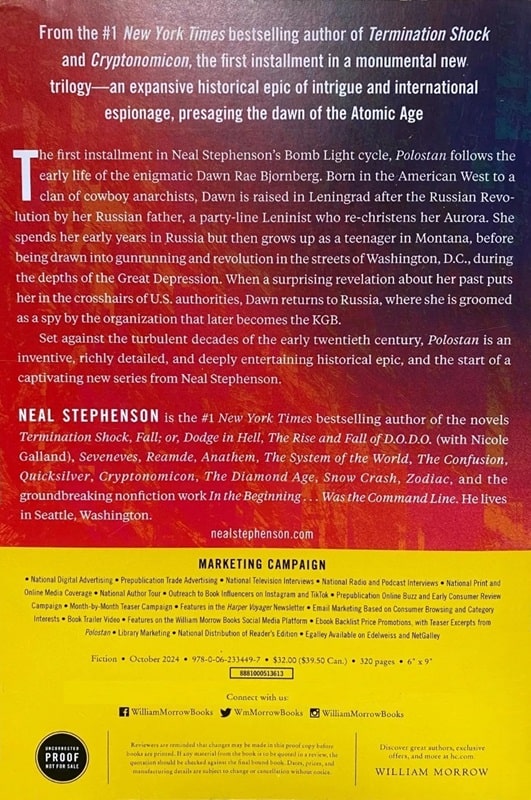
Polostan (William Morrow, October 15, 2024). Cover art uncredited
If, like me, you are a Neal Stephenson fan, you know he has a tendency to get deep into the descriptive weeds. I sometimes imagine his editor suggesting, “Neal, do we really need all this detail?” And then Neal grouchily responds, “If I didn’t think the story needed it, I wouldn’t have written it.”
Case in point from his latest novel, Polostan, a depiction of the 1933 Chicago World’s Fair Century of Progress exhibition where the protagonist, Dawn Rae Bjornberg, also known as Aurora Maximovna Artemyeva, works shilling for a shoe salesman:
She went to the fair early and stayed late, for the work was easy and there were plenty of diversions — that being the point of a fair. Her perambulations soon made her as conversant with the place as if it were an old city…As they were meant to, [the exhibits] drew visitors: 600 Norge salesmen on the B&O from Philly; 176 newsboys on the New York Central from Buffalo; 60 Episcopal bishops; 180 Civilian Conservation Corps workers en route to turpentine camps in the southeast; 100 Minnesota National Guard troops. Paramount Studios executives from Hollywood, Lions from St. Louis, Shriners from Fort Smith…
It goes on like this for quite a while. Do we really need to know that “Five hundred employees of the National Carbon Coated Paper Company of Sturgis, Michigan, arrived on the same train as 270 members of the Jewish Socialist Verband from New York City.” Probably not; it doesn’t further the plot, though it does provide a sort of Proustian vibe.
It’s also a metafictional joke Stephenson tells on himself. After Dawn/Aurora relates her life history to her Soviet inquisitor (which forms a kind of framework to a plethora of narratives, more about that in a second), he remarks, “You’ve been cooperative, if somewhat rambling. But that’s in the nature of your story — you really have been all over the place.”
“All over the place” is also how I’d describe this novel. But in a good way.
Born in 1916, a pivotal time in history when revolution was in the air, Dawn/Aurora’s childhood is split between Montana with her American radical mother and the Soviet Union with her Communist father (hence the American and Russian alter egos). Which makes her an ideal candidate for espionage against one of those countries. But which one is the question.
With an upbringing that includes acquiring equestrian skills, running guns and a fascination with Bonnie and Clyde as well as the Red Woman’s Death Battalion, the attention of then Major George Patton during an encampment of “Bonus Army” protesting World War I veterans in Washington, D.C., an abortion that makes her incapable of further pregnancy (and a matter-of-factly stated no-strings enticement to a prospective lover), and as a captive of con-artist evangelists as well as Soviet secret police OGPU led by the brutal Lavrentiy Beria. She is also witness to a deadly ballon ride by Soviet aeronauts named Elektron and Proton. We’ve already mentioned the Chicago World’s Fair.
But all of that is prologue and epilogue to Dawn’s chance meeting with “Dick,” a boy who impregnates her while on top of an early X-ray machine. Dick is probably Richard Feynman, who assisted in the development of the atomic bomb, but who here is a horny teenager happy to explain to Dawn current thinking in physics about possibly splitting the atom. Which makes her all the more a person of interest to Beria, who Stalin later appoints to head the Soviet atomic program. And which is why this is the first in a planned trilogy called Bomb Light.
Oh, and if you’re curious about what Polostan is supposed to mean, it is coined by British journalist Crisp-Upjohn, whom Aurora is tasked by the the OGPU to compromise, while playing against her during of an exhibition match with the Soviet women’s polo team.
So there is a lot here to unpack. But that Stephenson pulls off in a highly entertaining and brisk way. Because that is what Neal Stephenson does.
What there isn’t is a lot of is pages. While Stephenson is noted for producing doorstops, even for individual books in a series (The Baroque Cycle, for example, adds up to some 3,000 pages across three volumes), Polostan is a mere 303 pages. You might wonder why the author just didn’t produce one big book, other than that genre publishing suffers from a multi-volume series fixation. According to the author, the intent is to focus on a different character in each installment. “As far as the series format is concerned, we made a decision last year to bring it out one normal-sized book at a time, and to configure it in such a way that each volume will focus on one of the main characters. “
Also, Stephenson hasn’t finished writing it. So, there is that.
We wait with bated breath.
David Soyka is one of the founding bloggers at Black Gate. He’s written over 200 articles for us since 2008. His most recent was a review of Playground by Richard Powers.
Wizard of the Pigeons - Book Review
 Wizard of the Pigeonsby Megan Lindholm/Robin Hobb
Wizard of the Pigeonsby Megan Lindholm/Robin HobbWhat is it about:Seattle: a place as magical as the Emerald City. Subtle magic seeps through the cracks in the paving stones of the sprawling metropolis. But only the inhabitants who possess special gifts are open to the city's consciousness; finding portents in the graffiti, reading messages in the rubbish or listening to warnings in the skipping-rope chants of children.
Wizard is bound to Seattle and her magic. His gift is the Knowing -- a powerful enchantment allowing him to know the truth of things; to hear the life-stories of ancient mummies locked behind glass cabinets, to receive true fortunes from the carnival machines, to reveal to ordinary people the answers to their troubles and to safeguard the city's equilibrium. The magic has its price; Wizard must never have more than a dollar in his pocket, must remain celibate, and he must feed and protect the pigeons.
But a threat to Seattle has begun to emerge in the portents. A malevolent force born of Wizard's forgotten past has returned to prey upon his power and taunt him with images of his obscure history; and he is the only wizard in Seattle who can face the evil and save the city, his friends and himself.
What did I think of it:This is a reread. First time reading it has to be between 2001 and 2009 somewhere. I borrowed it and now finally have my own copy.
And even though I mainly remembered atmosphere and vibes, this is indeed as beautiful a read as I remember. The writing is beautiful and vivid, painting a clear picture of a Seattle full of magic. This is as much an ode to the whimsical history and hidden places of this city (which I hope are all real) as it is a powerful, emotional story about a man who when down on his luck discovers he's a wizard.
I loved Wizard, and I could understand him when things start getting dicey and he stumbles. I will say I had forgotten about one character he encounters, and how super annoying I found this character, but it all fits perfectly.
It was wonderful to revisit and rediscover this story, and you bet I will reread this again, especially now that I have this beautiful copy of it on my Keeper shelves.
Why should you read it:It's a beautifully written and emotional read.
Delirium by Lauren Oliver (Delirium #1)
They say that the cure for Love will make me happy and safe forever.
And I’ve always believed them.
Until now.
Now everything has changed.
Now, I’d rather be infected with love for the tiniest sliver of a second than live a hundred years smothered by a lie.
Lena looks forward to receiving the government-mandated cure that prevents the delirium of love and leads to a safe, predictable, and happy life, until ninety-five days before her eighteenth birthday and her treatment, when she falls in love.
Rating: 4 Stars
Favorite Quotes:
But it does not tell you this: that love will turn the whole world into something greater than itself.
Love, the deadliest of all deadly things: It kills you both when you have it and when you don’t.
This is a dystopian book that’s a little different from The Hunger Games & Divergent and the like. The world isn’t ending, necessarily but the government has mandated that everyone over the age of 18 has a procedure that basically renders you incapable of love and most of the other strong emotions. They literally cut a piece out of the brain to achieve this! I cannot imagine a time when the majority of people would be pushing for this to happen, but here it does. I guess I can see some appeal to not suffering through a broken heart but to cut out a piece of my brain to achieve this? Uhhhh, no thank you!
The story follow Lena Haloway as she is preparing for her procedure. She got about 3 months until it is scheduled and there are interviews that have to be done so that the government can pick a husband suitable for her (because if you don’t care, how could you choose for yourself?) and what she will do for a living (will she go to college or just get a job until she is married?). They regulate the music that your allowed to listen to and the books that you can read. Something that Oliver did that is really different from most dystopian stories is the fact that everything we once had still exists. There are cell phones and cars and the internet. They are all strictly monitored and not everyone has them but they are still in use. So many times you read these types of books and its like living in the dark ages and I thought this was a nice touch.
One of my gripes about this book is that if you take away the portion of the brain that controls emotion, how does anything get done? If you don’t care, how do you take care of your children or get up everyday and go to work and cook and clean? Love guides almost all the things we do. We work because we love our families and want to take care of them. We love our children and so we play with them and discipline them and laugh with them. If you remove all those things are you really still alive? Aren’t other things in our lives determined by a type of love? If you were a police man breaking up an illegal party with a bunch of teenagers involved, would you care enough to just send them home or would you release the dogs against them and beat them with clubs and would it matter either way? Very confusing to me. I guess if love was that simple and it could be removed without interfering with everything else, then maybe, but it simply affects too many things.
Anyway, the story drags on a bit for me once the world is set up and you get a grasp on what’s happening. Lena and Hana (her best friend) start to break the rules and go to unauthorized parties after curfew. Up until this point, they’ve had almost no contact with the opposite sex besides adult males (parents and teachers who have all had the procedure) and these parties are full of uncured boy their own age. So in typical teenager fashion they are rebelling before they can’t anymore. Then Lena meets a boy, Alex, who shows her that there is so much to be missed by having the procedure done and how much the cureds have been lying to everyone (particularly Lena). As they get to know each other and fall in love Lena realizes that there’s no way she could ever willing have the procedure and she tries to come up with a way for them to escape.
Will they find a way or will Lena have to lose part of herself?
*SPOILERS BELOW*
First of all, I cannot believe that there wasn’t a love triangle in this book! It was kind of nice to not have to be vacillating between two love interests!
I was wondering throughout the whole beginning of the book if it wouldn’t turn out that Lena’s Mom was still alive. Considering how long ago she supposedly killed herself she was still very present in Lena’s mind and that usually means something is coming up. It’s too bad that she didn’t get to see her before she escaped though.
I cannot BELIEVE that Alex doesn’t make it with Lena to the Wilds! He sacrifices himself up to the regulators so that Lena can get away. He got shot and captured but I’m not sure if he’s alive or not! What will she do now in the Wilds all alone? Being with Alex was the main reason she decided to run away in the first place! Sheesh, I wonder what Oliver has planned for book 2?
Unravel Me by Tahereh Mafi (Shatter Me #2)
tick
tick
tick
tick
tick
it’s almost
time for war.
Juliette has escaped to Omega Point. It is a place for people like her—people with gifts—and it is also the headquarters of the rebel resistance.
She’s finally free from The Reestablishment, free from their plan to use her as a weapon, and free to love Adam. But Juliette will never be free from her lethal touch.
Or from Warner, who wants Juliette more than she ever thought possible.
In this exhilarating sequel to Shatter Me, Juliette has to make life-changing decisions between what she wants and what she thinks is right. Decisions that might involve choosing between her heart—and Adam’s life.
Rating: 4.5 Stars
Favorite Quotes:
My troubles have arrived fashionably late to this conversation, inconsiderate beasts that they are.
It’s the kind of kiss that makes you realize oxygen is overrated.
He’s standing right in front of me and I miss him like I haven’t seen him in years.
“I think there’s something about the impermanence of life these days that makes it necessary to etch ink into our skin,” he says. “It reminds us that we’ve been marked by the world, that we’re still alive. That we’ll never forget.”
Another heart wrenching book by Mafi. She really is a wonderful writer. I couldn’t put the book down. I devoured it in a day and now I’m dying to know what happens next. I’m not sure but I think this is a three book series so the next one should be the end. I love the way your heart is practically in your throat the whole book. There is so much emotion happening and Mafi writes in a way that you can’t help but experience everything along with the characters.
Book two picks up shortly after where book one ended. Juliette, Adam and James have been at Omega Point for about a week and things are starting settle down. Once the immediate danger is over Juliette has retreated back inside herself because she is now surrounded by people who know what she can do and some of them include children. She doesn’t want to scare anyone and so she decides to just keep to herself and only really talk to and associate with Adam. What a hard thing to have to experience at the age of 17, to try to make friends when you’ve never done something like that before. She’s always been immediately ostracized when she was around other people and so she doesn’t know how to start getting to know people. I thought this was a good road for Mafi to take with this story, it makes it more believable. Because of this, she comes off even scarier than she would have if she even made some small attempt to interact with people. The story about how she killed that little kid years ago gets out and now everyone is looking at her just like people always have. So much for being with people who would understand her because she wasn’t the only one with some bizarre powers. Castle thinks that there might be more to Adam being able to touch her than it just being some fluke and now he’s undergoing some test to see if there’s another reason he can touch her. The results are devastating and now Juliette has to decide how she’s going to back away from him to keep him safe. She learning more about her own abilities and now she’s not just worried about her touch being dangerous. Her whole body is a weapon and she has no control over it. On top of that monumental obstacle, she is still keeping secrets from Adam. She hasn’t told him that Warner can touch her too and that she kissed him right before she shot him. I don’t know why she doesn’t say anything. She should have told him as soon as he was healed. There was no real reason for her not to except for the part where she actually enjoyed it. She could leave that part out of it as far as I’m concerned but the rest of it she should have told him. You can’t keep secrets like that. The fact is that if they really loved each other there would be no reason to keep these kinds of secrets. Adam might be a little pissed but the fact is she did what she needed to do so that she could save him and I don’t think that he would be angry for long.
Kenji plays a much bigger role in this book and I’m so glad because I love him! He’s like the only bright spot in the book; his personality is so bright and carefree that you can’t help but smile when he’s around. This is not to say that he doesn’t have some serious moments and he does put Juliette in her place a few times but she really needed someone to kick her in the ass so she would quit moping around. The reality is that she is the primary reason that The Reestablishment is hunting so fiercely for Omega Point. Not that this wouldn’t have come to a head at some point in the future but the timetable’s been moved up and that is because of Juliette. Warner can’t let her go and now that his father is involved he hasn’t got a choice but to find her. After learning more about him in Destroy Me I was pretty sure he would be a big part of this book as well. We learned even more about him and his past as him and Juliette spend some time together.
Kenji has been working with Juliette to help her figure out and hone her skills and she starts to get a little more control of it. I was hoping this would naturally lend itself to help with her self-esteem but that doesn’t really happen. If she should would just accept who and what she is life would start to become more manageable for her but she can’t stop seeing herself as a monster. She’s come out of her shell a little bit and it starting to make some friends but everyone at Omega Point is preparing to battle Warner’s father and his men and they need Juliette to help them. With the strength of her power she could be the edge that they need to win.
Will she be able to put her personal feelings aside and focus on the more important objective? Will she be able to use her abilities against the “bad guys” to save the innocent citizens of sector 54? How will she reconcile her feelings for Adam and Warner?
*SPOILERS BELOW*
Oh man this book was torture for me! I’m still so unsure who I want Juliette to end up with! Her and Adam have such an intense relationship and it’s been growing since they were kids. Now that they have finally found each other and Adam can actually touch her things were looking up. This was not to last, of course, and now Adam has discovered that he has an ability as well. He’s a disruptor and that’s why he can touch her because he can cancel out her power. The problem with this is that he has to be constantly on guard in order for it to work and that can’t happen when they are getting physical with each other. She nearly kills him at one point! So she’s decided to stay away from him and it’s destroying both of them. Then there’s Warner. This is the first time that Juliette really gets to know him for who he is instead of the leader of sector 54. When she was listening to his father tear him down and then again later when he was being held captive at Omega Point and she had to interrogate him. He was so sweet to her and let her see a part of himself that I don’t think he’s ever shown anyone else. The scars on his back, the way he really sees himself, the way he sees her and how she makes him feel. It was breathtaking to witness. Now she’s so confused about what to do and she hasn’t told Adam about any of this and she hasn’t told Warner that Adam is his brother (which shocked the hell out of me, by the way) and she’s somehow in the middle and unable to decides what to do. She’s also hiding a lot of information about Warner. She doesn’t tell anyone that she knows why he can touch her and what his ability is and I’m not sure why. What could it harm? It just makes her look worse for keeping it to herself. I think she loves them both but who is the better choice? Adam is so loving and caring and wants to take care of her and he loves her with a desperation that is a little frightening. Warner can be gentle and caring and he doesn’t pull any punches. He is who he is and he accept Juliette for who she is and what she is capable of. He also loves her in an overwhelmingly obsessive way. I wonder if this is something about Juliette or if it’s something in their DNA that she attracts? Either way it’s a tough decision.
I wish that Kenji wouldn’t have stopped Juliette from killing Anderson. That guy is a monster and someone needs to take care of him. I understand why he did it but at the same time you don’t go to war with someone in his position if you don’t have his replacement ready to take over. Then in the end when he just shot her in the chest and leaves! This was the only real issue I had with the book. Why would he have gone through the trouble of shooting her in front of Warner only to leave before he could witness what it did to him? And, why would he have had “the girls” kidnapped to use to heal him only to leave them behind? If anything, he should have at least taken them with him back to the capital.
I’m really looking forward to seeing how it all ends.
Destroy Me by Tahereh Mafi (Shatter Me #1.5)
Perfect for the fans of Shatter Me who are desperately awaiting the release of Unravel Me, this novella-length digital original will bridge the gap between these two novels from the perspective of the villain we all love to hate, Warner, the ruthless leader of Sector 45.
In Tahereh Mafi’s Shatter Me, Juliette escaped from The Reestablishment by seducing Warner—and then putting a bullet in his shoulder. But as she’ll learn in Destroy Me, Warner is not that easy to get rid of. . .
Back at the base and recovering from his near-fatal wound, Warner must do everything in his power to keep his soldiers in check and suppress any mention of a rebellion in the sector. Still as obsessed with Juliette as ever, his first priority is to find her, bring her back, and dispose of Adam and Kenji, the two traitors who helped her escape. But when Warner’s father, The Supreme Commander of The Reestablishment, arrives to correct his son’s mistakes, it’s clear that he has much different plans for Juliette. Plans Warner simply cannot allow.
Set after Shatter Me and before its forthcoming sequel, Unravel Me, Destroy Me is a novella told from the perspective of Warner, the ruthless leader of Sector 45
Rating: 5 Stars
Favorite Quotes:
It’s a strange thing, to never know peace. To know that no matter where you go, there is no sanctuary. That the threat of pain is always a whisper away.
Love is a heartless bastard. I’m driving myself insane.
I’m at a loss for words with this novella. At the end of Shatter Me I had already firmly decided that I didn’t like Warner. I didn’t necessarily think he was a bad person, per se, but that he wasn’t a good person either. Now I find myself saddened by his story. Raised by a man who never had a nice thing to say to him and never receiving any kind of affection. It’s very similar to Juliette’s story, really, only that in Warners situation it wasn’t because people couldn’t touch him but because no one did. It makes a lot more sense now why he felt to connected to Juliette and now that he has her journal from when she was institutionalized he’s even more determined to find her and bring her back to be with him. I’m not sure if he’s going to have much success with this due to the way he tried to get her affections the last time but I at least have a better feel for who he is and why he is the way he is. I think that anyone can change, given the proper motivation. The question is, will Warner want to change and is love enough of a motivator for him? I think we’ll find out in book two which is next up on the list.
Shatter Me by Tahereh Mafi (Shatter Me #1)
Juliette hasn’t touched anyone in exactly 264 days.
The last time she did, it was an accident, but The Reestablishment locked her up for murder. No one knows why Juliette’s touch is fatal. As long as she doesn’t hurt anyone else, no one really cares. The world is too busy crumbling to pieces to pay attention to a 17-year-old girl. Diseases are destroying the population, food is hard to find, birds don’t fly anymore, and the clouds are the wrong color.
The Reestablishment said their way was the only way to fix things, so they threw Juliette in a cell. Now so many people are dead that the survivors are whispering war– and The Reestablishment has changed its mind. Maybe Juliette is more than a tortured soul stuffed into a poisonous body. Maybe she’s exactly what they need right now.
Juliette has to make a choice: Be a weapon. Or be a warrior.
Rating: 4.5
Favorite Quotes:
Truth is a jealous, vicious mistress that never ever sleeps, is what I don’t tell him. I’ll never be okay.
my cheek is pressed against his chest and he smells like strength and courage and the wold is drowning in rain.
I remember you every day forever in every single broken moment of my life.
His hands are shaking so slightly, his eyes brimming with feeling, his heart thrumming with pain and affection and I want to live here, in his arms, in his eyes for the rest of my life.
I wasn’t sure what to expect from this book when I first picked it up. It was a recommendation from a friend and I thought, what the hell, I’d give it a shot. It was surprisingly good! The writing style took a little getting used to as most of what Juliette thinks is in run on sentences. This makes a little more sense once you figure out that she has been locked up all alone for almost a year and hasn’t spoken to another living soul for that whole time. I think I’d be a little nutty too. Mafi is a very emotionally descriptive writer and because of this it doesn’t take very long for you to be attached to certain characters and to really despise others. I only used four of my favorite lines from this book above but I think I highlighted around 10 or so which is really high for me in any book. I think she’s an amazing writer and once I got used to her writing style, I really liked it.
I’m not sure what year the book is set in but basically we’ve destroyed the planet and there’s not enough food or clean water and The Reestablishment has taken over power of everyone. They’ve decided that in order to correct the problems that society has caused they need to make several changes. Only the strong get to survive, they are getting rid of all the books they can find and trying to create a whole new language. All the unhealthy, weak and old are gotten rid of. It doesn’t specifically say how this happens maybe they are all killed or maybe they are just segregated from the rest of society? Juliette has some sort of weird power where it is dangerous for her to touch anyone. She had an incident in a grocery store and after that she was locked up in what she assumes is an insane asylum. One day she gets a cell mate, Adam Kent, and then things start to change a little for her. Can you imagine not speaking to anyone for a year? Just as she’s starting to get used to the idea of him she’s taken out of her cell and introduced to the sector leader for The Reestablishment, Warner, who informs her that he’d like her to join their cause. He thinks that her “talent” could be really useful to them. Which means, of course, that he would like her to help him kill the rebels. Warner takes her to their base and sets her up with a nice room and nice clothes and good meals and thinks that this is the way to get her to agree to join him. He’s got more on his mind than just how she can help their cause too. Luckily for her, people can’t touch her (at least not most people) so she seems to be relatively safe for the time being.
Adam has been assigned to guard her and as time goes on we learn a little about their past and get to see their relationship develop into something very sweet and intense. Juliette’s got to escape from The Reestablishment, especially from Warner as he’s got some kind of weird obsession with her, and Adam is going to help her to this. When they finally get free, it’s a mad dash to find their allies and get somewhere safe. Then everything gets turned on its head when they do finally find safety. Will this new group be the good guys? Will they want to use Juliette for her “talents” as well? With her suddenly being in a situation of acceptance, how will she handle it and will her and Adam be able to stay together?
*SPOILERS BELOW*
I love the relationship between Adam and Juliette. I wasn’t sure how this would work out in the beginning, since she can’t be touched and was relieved that Adam was the exception to this rule. The fact that they knew each other when they were younger went a long way with me to support the intensity of their feelings for each other. You can’t just meet someone and all of a sudden be in love with them. I liked that they each had formed feelings for the other growing up even though they had never had a conversation before now. Adam is so sweet to her and the fact that he remembered all the small things she did growing up for the same people who treated her so terribly was a nice touch. I’m not sure how this will all play out as Juliette has no experience with relationships of any kind. How will she handle something so intense?
I was disappointed to learn that Adam wasn’t the only one immune to Juliette’s dangerous touch when Warner touched her right before they escaped. I’m not sure exactly how I feel about Warner. I think that he is a product of his upbringing. Even though he can be ruthlessly cold and calculated, I’m not sure that he is a bad person. I think this is all he knows. He seems to have real feelings for Juliette although they way he got to know her was a little stalkerish with reading all about her history and then watching her in the asylum for the past year. He’s obsessive though and he’s not going to just let her go without some sort of fight.
I actually really loved the ending to this book! I totally didn’t see it coming. A whole group of people who all have different abilities. How wonderful for Juliette to finally feel like she belongs somewhere. Adam made a little headway with her self-esteem over the course of the few months they got to spend together but think about how horrible her life would have been. Can you imagine not being touched by anyone for almost your entire life? It’s pretty incredible that she’s still such a good person. The kind of power that she has would have been so dangerous in the wrong hands. The way her parents made her feel like a monster especially pissed me off. As a parent you love your children NO MATTER WHAT and how could you let her feel so alone her whole life? They could have ruined her forever. I’m excited to see what book two brings. I’d like to know what other kind of gifts the people of Omega Point have and how they deal with Warner and the threat he represents.
Next up is Destroy Me, a novella before Unravel Me.






Recent comments